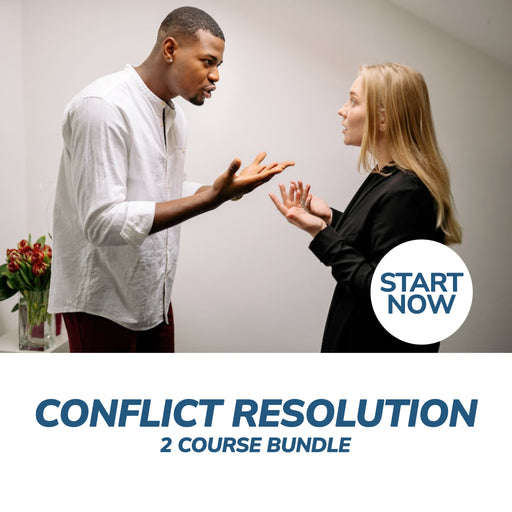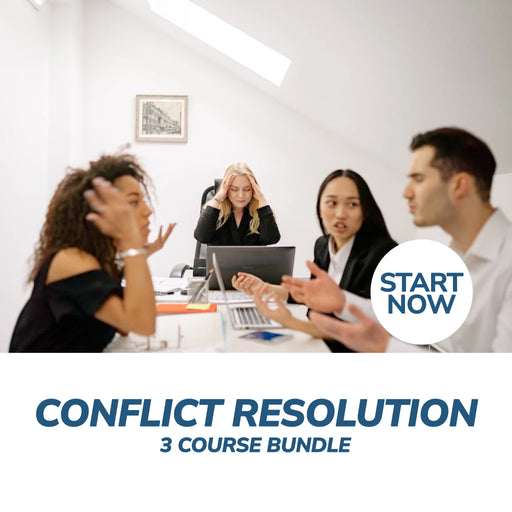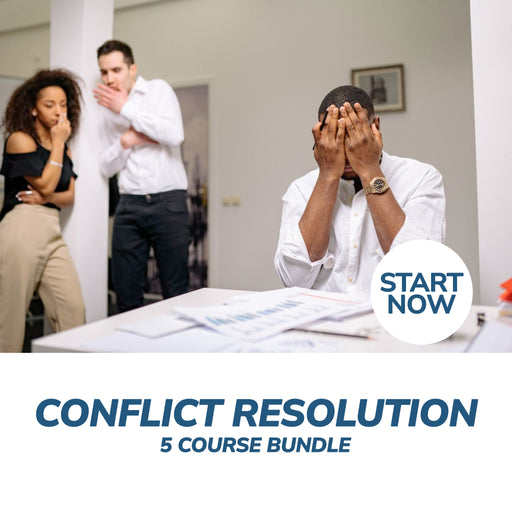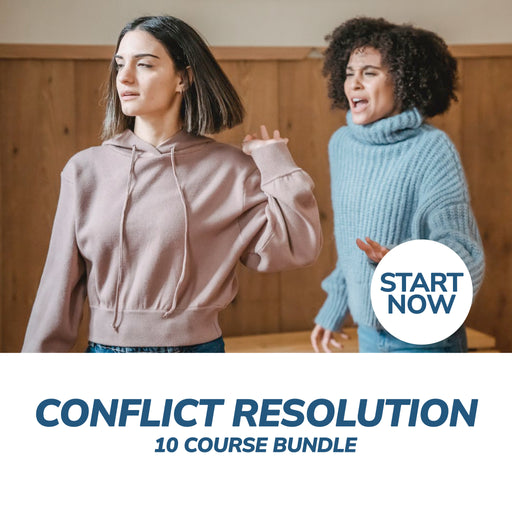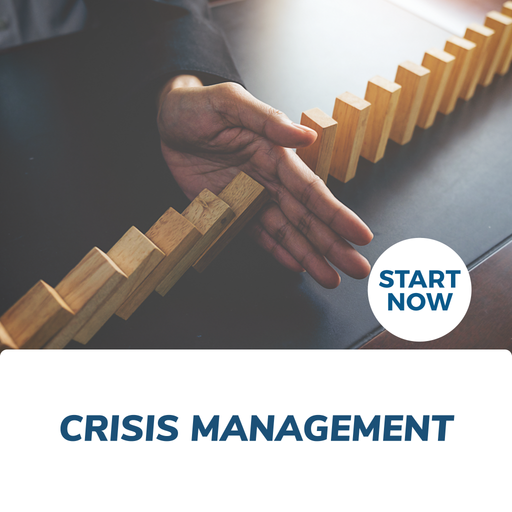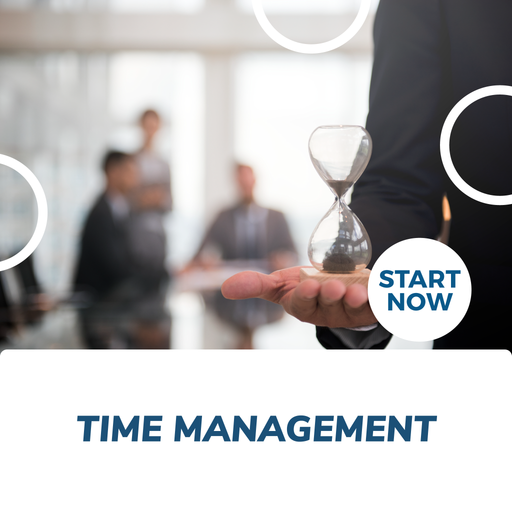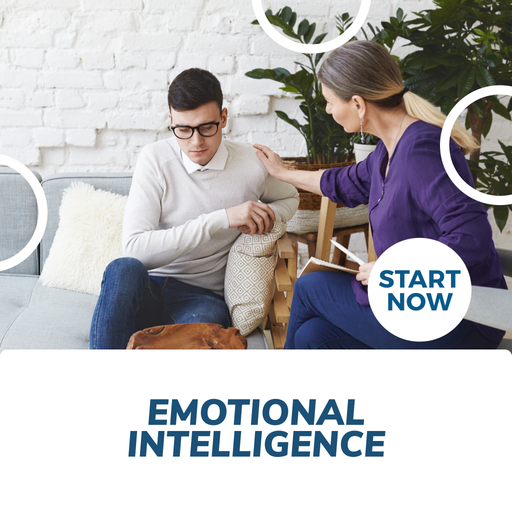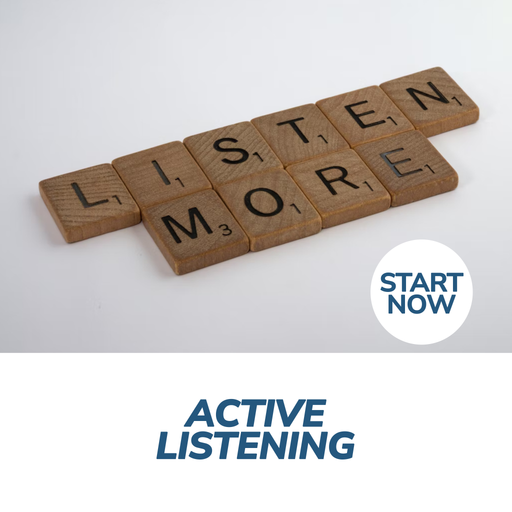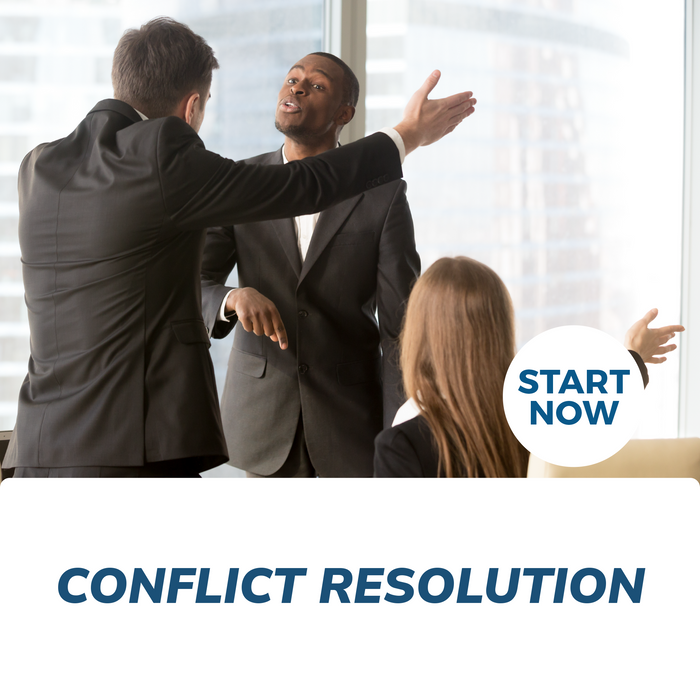
About This Course
What you will learn
|
|
Study Conflict Resolution Online Training; Resolve Conflict Efficiently and Effectively with Our Best Conflict Resolution Online Course
Learn how to resolve any conflicts effectively in a manner that allows for constructive change to occur. Our Conflict Resolution Online Certificate Course will teach you how to resolve disputes in satisfactory ways to all parties successfully.
Conflicts can be resolved in a variety of ways. It can be via surrender, avoidance, with force, legally. With our Conflict Resolution Online Training, you will learn how to create mutually agreeable outcomes to generate long-term benefits.
All of this and more can be learned through studying our comprehensive conflict resolution course online. The concept of resolving conflict was born out of realizing that violence and litigation were poor options in a cost and practical sense. Conflict resolution is now widely used in a vast range of industries encompassing a wide range of differing circumstances. Taking our Conflict Resolution Online Training will teach you the six-step process successfully employed to resolve any type or size of disputes.
Our Conflict Resolution Online course will also show you key resolution skills required, such as coping effectively with anger and making use of the Agreement Frame.
At course For Success, our training programs have been carefully developed by leading professionals and validated by industry experts to guarantee you are getting the most up-to-date experience. By enrolling in this course, you can be confident you are getting the best education possible.
Conflict Resolution Online Training - Requirements
The Conflict Resolution Online Certificate Course is delivered 100 percent online 24/7 and only takes 6 to 8 hours of study to complete.
To successfully complete this course, a student must:
- Have access to the internet and the necessary technical skills to navigate the online learning resources
- Have access to any mobile device with internet connectivity (laptop, desktop, tablet)
- Be a self-directed learner
- Possess sound language and literacy skills
Quick Course Facts
- Course content is structured for easy comprehension
- Approximately 6 to 8 hours of study is needed to complete the course
- Registered students gain unrestricted lifetime access to the Conflict Resolution Online Training
- All course material is available online 24/7 and can be accessed using any device
- Study online from anywhere in your own time at your own pace
- All students who complete the course will be awarded a certificate of completion
Conflict Resolution Online Training - Outline
Section One: Getting Started
Section Two: Introduction to Conflict Resolution
People are different, and conflicts happen when those differences are brought to the forefront. In this section, we will take a closer look at conflicts, the conflict resolution process, how to understand differences, and how to use these to interact in a more positive, productive way.
What is Conflict?
Conflicts are defined as “to come into collision or disagreement; be contradictory, at variance, or in opposition; clash.”
What is Conflict Resolution?
Conflict resolution refers to the process for parties of two or more individuals to work together to solve a disagreement between them. Disputes are resolved through negotiation or mediation to resolve the issues both parties disagree on.
Understanding the Conflict Resolution Process
In this part of the course, we explore the different conflict resolution processes.
- Create an Effective Atmosphere
- Create a Mutual Understanding
- Focus on Individual and Shared Needs
- Get to the Root Cause
- Generate Options
- Build a Solution
Section Three: Effective Conflict Resolution Styles
This section discusses the five widely accepted styles of resolving conflicts. We will focus on the collaborative style of conflict resolution, but we have also made it possible to combine this with other conflict resolution styles.
Collaborating
This conflict resolution style requires parties to work together to develop a win-win solution.
Competing
The competitive style takes a more aggressive approach to conflict resolution. It is when a person in conflict takes a firm stand, with each party competing for power until one party wins.
Compromising
In this conflict resolution style, each party gives up something in an effort to create a solution.
Accommodating
This conflict resolution style is one of the most passive with one party giving up what they want to give the other party what they want.
Avoiding
This approach is aimed at defusing the conflict entirely by one party accepting decisions without question to avoid confrontation.
Section Four: Creating a Communicative Atmosphere
Conflicts create a lot of negative energy. Anger, frustration, and disappointment are just some of the negative emotions that characterize conflicts. In this section of the Conflict Resolution Online Certificate course, you will learn how to create a positive atmosphere when trying to resolve conflicts.
Neutralizing Emotions
Both agree must first agree that they want to resolve the conflict. Without this, resolving conflicts can be difficult, if not impossible. Key steps for people in conflict include:
- Accept that you have negative feelings and that these feelings are normal.
- Acknowledge the feelings and their root causes. Example: “I feel very angry about the way George spoke to me in that meeting.”
Setting Ground Rules
Ground rules create a foundation where conflicting parties can start resolving their conflict. Your basic framework for ground rules should be:
- Developed and agreed upon by both parties.
- Positive when it is possible. (For example, “We will listen to each other’s statements fully,” rather than, “We will not interrupt.”)
- Fair to both parties
- Enforceable
- Adjustable
- Written and posted somewhere where both parties can refer to it (for more formal dispute resolution processes).
Choosing the Time and Place
A key component when resolving conflicts is conducting this at the proper time and place. Ideally, this should be done in a quiet place and away from distractions.
Section Five: Creating a Mutual Understanding
Finding a win-win situation is the preferred outcome for any conflict. In this section, we will discuss how creating mutual understanding can form the basis for a win-win solution.
What Do I Want?
To start the process, parties should first identify what they want out of the conflict. However, for this to work, both parties should state this positively.
What Do They Want?
After identifying what a party wants, the next step is to determine what the other party wants. To be successful, you must generate as many questions from as many angles as possible.
What Do We Want?
After determining the needs and wants of both parties, look for areas where these wants overlap. These areas can form the basis for establishing mutual ground.
When working through the wants and needs of both parties, be careful not to jump to conclusions. Rather, be on the lookout for the root cause. Often, the problem is not what it seems.
Section Six: Focusing on Individual and Shared Needs
This section discusses the different techniques of building common ground and using it to create partnerships. We will also take a look at some of the steps essential for achieving the best solution possible for the situation.
Finding Common Ground
We have previously discussed finding common ground by determining each party's wants and needs. Finding common ground should be a continuing process throughout the entire conflict resolution process. This is to ensure that a win-win solution and bring the two parties working towards solving a problem.
Building Positive Energy and Goodwill
Conflicts result in the creation of negative emotions on both parties. Turning negative energy into something positive can go a long way into building goodwill with the person you conflict with. Below are some ways to build positive energy.
- Have a good attitude.
- Frame things positively.
- Create actionable items.
Strengthening Your Partnership
Turning conflicting parties into problem-solving teammates are one of the most effective resolution tools. This can be achieved by first establishing a common ground to help bridge the gap between parties.
Section Seven: Getting to the Root Cause
In this section, you will learn how to get to the root cause of conflict. This is essential for establishing a long-term solution rather than a band-aid solution.
Examining Root Causes
After laying the foundation, the next step is to examine the root causes of the conflict. A simple verbal investigation can do this.
Creating a Cause and Effect Diagram
Another way of getting to the root of the conflict is by creating a cause and effect diagram. This process can be time-consuming but is an excellent tool for complicated or team conflicts. This diagram should also be constantly updated as new cases are discovered.
The Importance of Forgiveness
Forgiveness is an essential concept in conflict resolution. Forgiveness does not mean forgetting but doing away with the ill-feelings it created. It also involves accepting the consequences and moving forward.
Identifying the Benefits of Resolution
Conflict resolution involves digging deep into the issues, exploring unfamiliar territory, to get to the core of the conflict and prevent the conflict from reoccurring. While the benefits of conflict resolution can be obvious, another way of determining the benefits is by asking what would happen if the conflict was not resolved.
Section Eight: Generating Options
In this section, we will discuss the different options for resolutions available when resolving a conflict. During this stage, it is essential that you generate as many options as possible so you can have a wider selection of solutions to choose from.
Generate, Don’t Evaluate
This is not the time to determine the quality of the solution. During this stage, your main objective is to generate as many ideas on how to resolve the conflict.
Creating Mutual Gain Options and Multiple Option Solutions
After creating a good list of options, it is now time to look over the list and perform some basic evaluation.
Digging Deeper into Your Options
Begin narrowing the list and dig deeper into each option and identify the following:
- The effort for each option (perhaps on a scale of one to ten)
- The payback for each option (also on a scale of one to ten)
Section Nine: Building a Solution
This section discusses creating a criterion and using criteria to create a shortlist of options before moving on to a solution.
Creating Criteria
First, set aside your list of options and start building a framework for evaluating options. This framework should focus on the wants and needs of both parties.
Creating a Shortlist
After the criteria have been created, it is now time to bring out the list of solutions. You must remove any solutions that do not meet the must-have criteria that you and your partner identified.
Choosing a Solution
After creating a shortlist, you are now in a position to choose a final solution. Below is a checklist to help you evaluate your chosen solution.
- Is it a win-win solution for everyone involved?
- Are all needs provided for?
- Are all criteria met?
Building a Plan
This is the time to create a plan to put the solution in action. Simple situations require simple plans, while more complex conflicts require a more detailed plan.
Section Ten: The Short Version of the Process
In the past sections, we explored the six phases of conflict resolution. This part of the course discusses an abridged version of the processes that can be used to resolve conflicts easily.
Evaluating the Situation
- Phase One (Creating an Effective Atmosphere)
- Phase Two (Creating a Mutual Understanding)
- Phase Three (Focusing on Individual and Shared Goals)
Choosing Your Steps
Make a shortlist of possible solutions and move on to the next phase.
Creating an Action Plan
Make a quick evaluation after selecting some ideas on how to resolve the conflict. It is also a good idea to create a backup plan in case your approach doesn’t work.
Using Individual Process Steps
You have learned the different steps in conflict resolution. But in some cases, some of these processes can be used individually as a conflict resolution tool.
Module Eleven: Additional Tools
To help wrap up this course, we would like to share some additional tools that can help you resolve conflicts.
- Stress and Anger Management Techniques
- The Agreement Frame
- Asking Open Questions
Module Twelve: Wrapping Up
Recognition & Accreditation
Upon successful completion of this course and achieving a passing score for the assessment, you will be issued with an international continuing education credit (CEU) certificate.
This Certificate is applicable worldwide, which demonstrates your commitment to learning new skills. You can share the certificate with your friends, relatives, co-workers, and potential employers. Also, include it in your resume/CV, professional social media profiles and job applications.
Other Workplace Soft Skills course
If you’d like to help your workplace flourish, take a look at the range of workplace essentials course available at course For Success.
Units of Study
Section One: Getting Started
Section Two: Introduction to Conflict Resolution
- Conflict, What Is It?
- What is Effective Conflict Resolution?
- Understanding the Effective Conflict Resolution Process
Section Three: Effective Conflict Resolution Styles
- Collaborating
- Competing
- Compromising
- Accommodating
- Avoiding
Section Four: Creating a Communicative Atmosphere
- Defuse Emotions
- Setting Ground Rules
- Choosing the Time and Place
Section Five: Mutual Understanding
- What Do I Want?
- What Do They Want?
- What Do We Want?
Section Six: Focusing on Individual and Shared Needs
- Identify Common Ground
- Build Positive Energy and Goodwill
- Strengthen Your Partnership
Section Seven: Analysing to the Root Cause
- Examining Root Causes
- Creating a Cause and Effect Diagram
- Identifying the Benefits of Resolution
Section Eight: Create Options
- Generate, Don’t Evaluate
- Creating Mutual Gain Options and Multiple Option Solutions
- Digging Deeper into Your Options
Section Nine: Solution Building
- Creating Criteria
- Creating a Shortlist
- Choosing a Solution
- Building a Plan
Module Ten: The Short Version of the Process
- Evaluating the Situation
- Choosing Your Steps
- Creating an Action Plan
- Using Individual Process Steps
Module Eleven: Additional Tools
- Stress and Anger Management Techniques
- The Agreement Frame
- Asking Open Questions
Module Twelve: Wrapping Up
Requirements
Entry requirements
Students must have basic literacy and numeracy skills.
Minimum education
Open entry. Previous schooling and academic achievements are not required for entry into this course.
Computer requirements
Students will need access to a computer and the internet.
Minimum specifications for the computer are:
Windows:
Microsoft Windows XP, or laterModern and up to date Browser (Internet Explorer 8 or later, Firefox, Chrome, Safari)
MAC/iOS
OSX/iOS 6 or laterModern and up to date Browser (Firefox, Chrome, Safari)
All systems
Internet bandwidth of 1Mb or fasterFlash player or a browser with HTML5 video capabilities(Currently Internet Explorer 9, Firefox, Chrome, Safari)
Students will also need access the following applications:
Adobe Acrobat Reader
Requirements
Entry requirements:
Students must have basic literacy and numeracy skills.
Minimum education:
Open entry. Previous schooling and academic achievements are not required for entry into this course.
Device requirements:
Students will need access to a computer/any device and the internet.
FAQS
1. Who are Courses For Success?
Courses For Success is a course platform that started in 2008
with 5 courses, since then we have grown to over 10,000 online courses.
Our courses span across the following categories:
•Animal
•Beauty
•Business
•Health & Fitness
•Finance
•Lifestyle
•IT & Software
•Personal Development
•Teaching & Academics
2. Is there a refund/cancellation policy?
Yes, we have a 7-day money-back refund guarantee. Just send us an email to info@coursesforsuccess.com with the subject Courses For Success Refund so we can accommodate your request.
3. What is the FREE Personal Success Training Program?
The Personal Success Training Program
was developed by Courses For Success to help our customers achieve
success. Currently, we are offering this program for FREE with every
course or bundle purchase this month. This is a limited time offer!
4. Are there any requirements to study this course?
No,
anyone who has an interest in learning more about this subject matter
is encouraged to take our course. There are no entry requirements to
take this course.
5. Do I require to have finished high school to complete this course?
No,
you do not require a High School Diploma or to have finished school to
study this course, this course is open to anyone who would like to take
this course.
6. What if English is not my first language?
This
course is provided in English, however, due to the digital nature of
our training, you can take your time studying the material and make use
of tools such as google translate and Grammarly.
7. Is this course online or conducted in person?
All our courses are accessible online on any device. You may complete them at your own pace and at your own time.
8. How do I receive my course?
After
you have completed the payment, you will receive a confirmation email
and tax receipt. You will also receive an email containing your course
login details (username and password), as well as instructions on how to
access and log in to your course via the internet with any device,
please check your junk/spam folder in the event that you do not receive
the email.
9. When does this course start?
Providing
you have internet access you can start this course whenever you like,
just go to the login page and insert your username and password and you
can access the online material.
10. What is online learning like?
Online learning is easy, if not easier than a traditional academic situation.
By studying an online course, the usual boundaries caused by location and time constraints are eliminated, meaning you are free to study where and when you want at your own pace.
Of course, you will need to be able to self-manage your time and be organized, but with our help, you’ll soon find yourself settling into a comfortable rhythm of study.
11. What computer skills do I need for my course?
You
don't need to be a computer expert to succeed with our online training,
but you should be comfortable typing, using the internet and be capable
of using common software (such as Microsoft word).
12. How long will you have access to the online course?
The majority of our courses have unlimited lifetime access, meaning you can access this course whenever you want.
Please also check the course summary, as a small selection of courses have limited access.
13. How long will my course take?
Course duration, is listed under Course Summary
14. Do I need to buy textbooks?
All the required material for your course is included in the online system, you do not need to buy anything else.
15. Is the course interactive?
Yes, all our courses are interactive.
16. Is there an assessment or exam?
Yes,
you will be required to complete a multiple-choice test online at the
end of your course, you can do this test as many times as you require.
17. What type of certificate will I receive?
You
will receive a Certificate of Completion that is applicable worldwide,
which demonstrates your commitment to learning new skills. You can share
the certificate with your friends, relatives, co-workers and employers.
Also, include it in your resume/CV, professional social media profiles
and job applications.
Wendy Sue Hunt - 5 STAR REVIEW
"If you are considering taking any “Courses for Success”, I would highly recommend it. I have always been a firm believer it’s important to always sharpen your skills. You are never too old to learn more. I found the courses very helpful, interesting and easy to understand.
The term “Courses for Success” helped me in my current position to succeed. After completing the courses, I gave my manager the completion certificates. Recently I received a promotion too."
Valencia Marie Aviles - 5 STAR REVIEW
"I
had a very good experience with my course. It has helped me to get
multiple jobs and prepared me for almost everything I would need to
know. The course was very informative and easy to understand and broken
up perfectly to be done in a short amount of time while still learning a
good amount! I would recommend Courses for Success to anyone trying to
get abs certifications for job advancements, it is well worth it!"
ELENA GRIFFIN - 5 STAR REVIEW
"I have absolutely enjoyed the materials from Courses for Success. The materials are easy to understand which makes learning enjoyable. Courses for Success have great topics of interest which make you come back for
more.
Thank you Courses for Success for being part of my learning journey and making education affordable!"
Our
completion certificates are very valuable and will help you progress in
your work environment and show employers how committed you are to learn
new skills, you might even get a promotion.
18. Will this course be credited by universities?
No, it is not equivalent to a college or university credit.
19. Am I guaranteed to get a job with this certificate?
This course will give you the skills you need to help you obtain employment, but it’s up to you if you get the job or not.
20. How will this course assist me with my career?
Studying
and completing this course will show employers that you have the
knowledge in this field, additionally you will gain more confidence in
this area of expertise.
21. How long is the certificate valid for?
The Certificates are valid for life and do not need renewing.
22. Can I take more than one course at a time?
Courses
are studied online at your own pace and you are free to study as many
or as few courses as you wish, we also offer online course bundles that
allow you to save on additional courses so that you may get all the
topics related to your training goals in one go.
23. What are the Payment Methods available? Is there a payment plan?
We accept payments via PayPal, Credit Card and Bank Transfer.
Payment Plans: We have partnered with Partial.ly, to offer our own in house payment plan. Everyone is Pre-Approved, providing the initial deposit is paid in full.
To pay via bank transfer contact us info@coursesforsuccess.com
24. Can I purchase for multiple people?
Yes, you can do this by purchasing individually via website or send us a request via email at info@coursesforsuccess.com
25. Can I request for an invoice before purchase?
Yes, you can request for an invoice via email at info@coursesforsuccess.com
26. Purchase for a gift?
Yes, you can purchase this course as a gift, simply send an email to info@coursesforsuccess.com, with the course details and we can accommodate this.
27. Can I create my own course bundle?
Yes,
you can customize your own bundle. Please send us the complete list
with the exact course link of the courses you'd like to bundle up via
email info@coursesforsuccess.com and we will create them for you. *Each course access, time of completion and certification varies depending on the course type.
28. How will I contact Courses For Success if I have any questions?
You can contact our support team, at any time through live chat on our website, or email at info@coursesforsuccess.com, or by calling one of our phone numbers depending on which country you are in.
Free Personal Success Training Course
The Personal Success Training Program Helps You Stay Focused To Achieve Your Goals!
This month, we are providing it for Free with all Course Purchases, as a special offer!
Benefits:
• How to layout a Success Plan.
• Get where you want to be in life.
• How to unclutter your mind to succeed.
• Achieve your dreams using your imagination.
• How to have faith in yourself.
Features:
• Life time access
• Complement your individual course purchase.
• Click here Personal Success Training Program to see thousands of positive reviews,
Hurry - offer - ends this month!
Course Bundles
Looking for specific training for yourself or employees. Choose from our Course Bundles below or build you own Bundle, by adding more courses to your cart. Choose different courses or the same course for multiple staff members and receive volume discounts at checkout.
Conflict Resolution Online Certificate Course
"I have enjoyed the conflict resolution course: the phases and styles. Its detailed case studies are relevant. i am enlightened and know how I will handle conflict in the future." - Portia M. Verified Buyer
Our Conflict Resolution Online Certificate Course will teach you how to resolve disputes in satisfactory ways for all parties successfully.
Bundle Up & Save - Learn More and Save More when you Upgrade to one of our Course Bundles below - Save Up To 98%
Course Summary
- Delivery: Online
- Access: Unlimited Lifetime
- Time: Study at your own pace
- Duration: 6-8 Hours
- Assessments: Yes
- Qualification: Certificate
3 DAY SALE - ENDS MIDNIGHT TODAY
GET IN NOW & SAVE!
About This Course
What you will learn
|
|
Study Conflict Resolution Online Training; Resolve Conflict Efficiently and Effectively with Our Best Conflict Resolution Online Course
Learn how to resolve any conflicts effectively in a manner that allows for constructive change to occur. Our Conflict Resolution Online Certificate Course will teach you how to resolve disputes in satisfactory ways to all parties successfully.
Conflicts can be resolved in a variety of ways. It can be via surrender, avoidance, with force, legally. With our Conflict Resolution Online Training, you will learn how to create mutually agreeable outcomes to generate long-term benefits.
All of this and more can be learned through studying our comprehensive conflict resolution course online. The concept of resolving conflict was born out of realizing that violence and litigation were poor options in a cost and practical sense. Conflict resolution is now widely used in a vast range of industries encompassing a wide range of differing circumstances. Taking our Conflict Resolution Online Training will teach you the six-step process successfully employed to resolve any type or size of disputes.
Our Conflict Resolution Online course will also show you key resolution skills required, such as coping effectively with anger and making use of the Agreement Frame.
At course For Success, our training programs have been carefully developed by leading professionals and validated by industry experts to guarantee you are getting the most up-to-date experience. By enrolling in this course, you can be confident you are getting the best education possible.
Conflict Resolution Online Training - Requirements
The Conflict Resolution Online Certificate Course is delivered 100 percent online 24/7 and only takes 6 to 8 hours of study to complete.
To successfully complete this course, a student must:
- Have access to the internet and the necessary technical skills to navigate the online learning resources
- Have access to any mobile device with internet connectivity (laptop, desktop, tablet)
- Be a self-directed learner
- Possess sound language and literacy skills
Quick Course Facts
- Course content is structured for easy comprehension
- Approximately 6 to 8 hours of study is needed to complete the course
- Registered students gain unrestricted lifetime access to the Conflict Resolution Online Training
- All course material is available online 24/7 and can be accessed using any device
- Study online from anywhere in your own time at your own pace
- All students who complete the course will be awarded a certificate of completion
Conflict Resolution Online Training - Outline
Section One: Getting Started
Section Two: Introduction to Conflict Resolution
People are different, and conflicts happen when those differences are brought to the forefront. In this section, we will take a closer look at conflicts, the conflict resolution process, how to understand differences, and how to use these to interact in a more positive, productive way.
What is Conflict?
Conflicts are defined as “to come into collision or disagreement; be contradictory, at variance, or in opposition; clash.”
What is Conflict Resolution?
Conflict resolution refers to the process for parties of two or more individuals to work together to solve a disagreement between them. Disputes are resolved through negotiation or mediation to resolve the issues both parties disagree on.
Understanding the Conflict Resolution Process
In this part of the course, we explore the different conflict resolution processes.
- Create an Effective Atmosphere
- Create a Mutual Understanding
- Focus on Individual and Shared Needs
- Get to the Root Cause
- Generate Options
- Build a Solution
Section Three: Effective Conflict Resolution Styles
This section discusses the five widely accepted styles of resolving conflicts. We will focus on the collaborative style of conflict resolution, but we have also made it possible to combine this with other conflict resolution styles.
Collaborating
This conflict resolution style requires parties to work together to develop a win-win solution.
Competing
The competitive style takes a more aggressive approach to conflict resolution. It is when a person in conflict takes a firm stand, with each party competing for power until one party wins.
Compromising
In this conflict resolution style, each party gives up something in an effort to create a solution.
Accommodating
This conflict resolution style is one of the most passive with one party giving up what they want to give the other party what they want.
Avoiding
This approach is aimed at defusing the conflict entirely by one party accepting decisions without question to avoid confrontation.
Section Four: Creating a Communicative Atmosphere
Conflicts create a lot of negative energy. Anger, frustration, and disappointment are just some of the negative emotions that characterize conflicts. In this section of the Conflict Resolution Online Certificate course, you will learn how to create a positive atmosphere when trying to resolve conflicts.
Neutralizing Emotions
Both agree must first agree that they want to resolve the conflict. Without this, resolving conflicts can be difficult, if not impossible. Key steps for people in conflict include:
- Accept that you have negative feelings and that these feelings are normal.
- Acknowledge the feelings and their root causes. Example: “I feel very angry about the way George spoke to me in that meeting.”
Setting Ground Rules
Ground rules create a foundation where conflicting parties can start resolving their conflict. Your basic framework for ground rules should be:
- Developed and agreed upon by both parties.
- Positive when it is possible. (For example, “We will listen to each other’s statements fully,” rather than, “We will not interrupt.”)
- Fair to both parties
- Enforceable
- Adjustable
- Written and posted somewhere where both parties can refer to it (for more formal dispute resolution processes).
Choosing the Time and Place
A key component when resolving conflicts is conducting this at the proper time and place. Ideally, this should be done in a quiet place and away from distractions.
Section Five: Creating a Mutual Understanding
Finding a win-win situation is the preferred outcome for any conflict. In this section, we will discuss how creating mutual understanding can form the basis for a win-win solution.
What Do I Want?
To start the process, parties should first identify what they want out of the conflict. However, for this to work, both parties should state this positively.
What Do They Want?
After identifying what a party wants, the next step is to determine what the other party wants. To be successful, you must generate as many questions from as many angles as possible.
What Do We Want?
After determining the needs and wants of both parties, look for areas where these wants overlap. These areas can form the basis for establishing mutual ground.
When working through the wants and needs of both parties, be careful not to jump to conclusions. Rather, be on the lookout for the root cause. Often, the problem is not what it seems.
Section Six: Focusing on Individual and Shared Needs
This section discusses the different techniques of building common ground and using it to create partnerships. We will also take a look at some of the steps essential for achieving the best solution possible for the situation.
Finding Common Ground
We have previously discussed finding common ground by determining each party's wants and needs. Finding common ground should be a continuing process throughout the entire conflict resolution process. This is to ensure that a win-win solution and bring the two parties working towards solving a problem.
Building Positive Energy and Goodwill
Conflicts result in the creation of negative emotions on both parties. Turning negative energy into something positive can go a long way into building goodwill with the person you conflict with. Below are some ways to build positive energy.
- Have a good attitude.
- Frame things positively.
- Create actionable items.
Strengthening Your Partnership
Turning conflicting parties into problem-solving teammates are one of the most effective resolution tools. This can be achieved by first establishing a common ground to help bridge the gap between parties.
Section Seven: Getting to the Root Cause
In this section, you will learn how to get to the root cause of conflict. This is essential for establishing a long-term solution rather than a band-aid solution.
Examining Root Causes
After laying the foundation, the next step is to examine the root causes of the conflict. A simple verbal investigation can do this.
Creating a Cause and Effect Diagram
Another way of getting to the root of the conflict is by creating a cause and effect diagram. This process can be time-consuming but is an excellent tool for complicated or team conflicts. This diagram should also be constantly updated as new cases are discovered.
The Importance of Forgiveness
Forgiveness is an essential concept in conflict resolution. Forgiveness does not mean forgetting but doing away with the ill-feelings it created. It also involves accepting the consequences and moving forward.
Identifying the Benefits of Resolution
Conflict resolution involves digging deep into the issues, exploring unfamiliar territory, to get to the core of the conflict and prevent the conflict from reoccurring. While the benefits of conflict resolution can be obvious, another way of determining the benefits is by asking what would happen if the conflict was not resolved.
Section Eight: Generating Options
In this section, we will discuss the different options for resolutions available when resolving a conflict. During this stage, it is essential that you generate as many options as possible so you can have a wider selection of solutions to choose from.
Generate, Don’t Evaluate
This is not the time to determine the quality of the solution. During this stage, your main objective is to generate as many ideas on how to resolve the conflict.
Creating Mutual Gain Options and Multiple Option Solutions
After creating a good list of options, it is now time to look over the list and perform some basic evaluation.
Digging Deeper into Your Options
Begin narrowing the list and dig deeper into each option and identify the following:
- The effort for each option (perhaps on a scale of one to ten)
- The payback for each option (also on a scale of one to ten)
Section Nine: Building a Solution
This section discusses creating a criterion and using criteria to create a shortlist of options before moving on to a solution.
Creating Criteria
First, set aside your list of options and start building a framework for evaluating options. This framework should focus on the wants and needs of both parties.
Creating a Shortlist
After the criteria have been created, it is now time to bring out the list of solutions. You must remove any solutions that do not meet the must-have criteria that you and your partner identified.
Choosing a Solution
After creating a shortlist, you are now in a position to choose a final solution. Below is a checklist to help you evaluate your chosen solution.
- Is it a win-win solution for everyone involved?
- Are all needs provided for?
- Are all criteria met?
Building a Plan
This is the time to create a plan to put the solution in action. Simple situations require simple plans, while more complex conflicts require a more detailed plan.
Section Ten: The Short Version of the Process
In the past sections, we explored the six phases of conflict resolution. This part of the course discusses an abridged version of the processes that can be used to resolve conflicts easily.
Evaluating the Situation
- Phase One (Creating an Effective Atmosphere)
- Phase Two (Creating a Mutual Understanding)
- Phase Three (Focusing on Individual and Shared Goals)
Choosing Your Steps
Make a shortlist of possible solutions and move on to the next phase.
Creating an Action Plan
Make a quick evaluation after selecting some ideas on how to resolve the conflict. It is also a good idea to create a backup plan in case your approach doesn’t work.
Using Individual Process Steps
You have learned the different steps in conflict resolution. But in some cases, some of these processes can be used individually as a conflict resolution tool.
Module Eleven: Additional Tools
To help wrap up this course, we would like to share some additional tools that can help you resolve conflicts.
- Stress and Anger Management Techniques
- The Agreement Frame
- Asking Open Questions
Module Twelve: Wrapping Up
Recognition & Accreditation
Upon successful completion of this course and achieving a passing score for the assessment, you will be issued with an international continuing education credit (CEU) certificate.
This Certificate is applicable worldwide, which demonstrates your commitment to learning new skills. You can share the certificate with your friends, relatives, co-workers, and potential employers. Also, include it in your resume/CV, professional social media profiles and job applications.
Other Workplace Soft Skills course
If you’d like to help your workplace flourish, take a look at the range of workplace essentials course available at course For Success.
Units of Study
Section One: Getting Started
Section Two: Introduction to Conflict Resolution
- Conflict, What Is It?
- What is Effective Conflict Resolution?
- Understanding the Effective Conflict Resolution Process
Section Three: Effective Conflict Resolution Styles
- Collaborating
- Competing
- Compromising
- Accommodating
- Avoiding
Section Four: Creating a Communicative Atmosphere
- Defuse Emotions
- Setting Ground Rules
- Choosing the Time and Place
Section Five: Mutual Understanding
- What Do I Want?
- What Do They Want?
- What Do We Want?
Section Six: Focusing on Individual and Shared Needs
- Identify Common Ground
- Build Positive Energy and Goodwill
- Strengthen Your Partnership
Section Seven: Analysing to the Root Cause
- Examining Root Causes
- Creating a Cause and Effect Diagram
- Identifying the Benefits of Resolution
Section Eight: Create Options
- Generate, Don’t Evaluate
- Creating Mutual Gain Options and Multiple Option Solutions
- Digging Deeper into Your Options
Section Nine: Solution Building
- Creating Criteria
- Creating a Shortlist
- Choosing a Solution
- Building a Plan
Module Ten: The Short Version of the Process
- Evaluating the Situation
- Choosing Your Steps
- Creating an Action Plan
- Using Individual Process Steps
Module Eleven: Additional Tools
- Stress and Anger Management Techniques
- The Agreement Frame
- Asking Open Questions
Module Twelve: Wrapping Up
Requirements
Entry requirements
Students must have basic literacy and numeracy skills.
Minimum education
Open entry. Previous schooling and academic achievements are not required for entry into this course.
Computer requirements
Students will need access to a computer and the internet.
Minimum specifications for the computer are:
Windows:
Microsoft Windows XP, or laterModern and up to date Browser (Internet Explorer 8 or later, Firefox, Chrome, Safari)
MAC/iOS
OSX/iOS 6 or laterModern and up to date Browser (Firefox, Chrome, Safari)
All systems
Internet bandwidth of 1Mb or fasterFlash player or a browser with HTML5 video capabilities(Currently Internet Explorer 9, Firefox, Chrome, Safari)
Students will also need access the following applications:
Adobe Acrobat Reader
Requirements
Entry requirements:
Students must have basic literacy and numeracy skills.
Minimum education:
Open entry. Previous schooling and academic achievements are not required for entry into this course.
Device requirements:
Students will need access to a computer/any device and the internet.
FAQS
1. Who are Courses For Success?
Courses For Success is a course platform that started in 2008
with 5 courses, since then we have grown to over 10,000 online courses.
Our courses span across the following categories:
•Animal
•Beauty
•Business
•Health & Fitness
•Finance
•Lifestyle
•IT & Software
•Personal Development
•Teaching & Academics
2. Is there a refund/cancellation policy?
Yes, we have a 7-day money-back refund guarantee. Just send us an email to info@coursesforsuccess.com with the subject Courses For Success Refund so we can accommodate your request.
3. What is the FREE Personal Success Training Program?
The Personal Success Training Program
was developed by Courses For Success to help our customers achieve
success. Currently, we are offering this program for FREE with every
course or bundle purchase this month. This is a limited time offer!
4. Are there any requirements to study this course?
No,
anyone who has an interest in learning more about this subject matter
is encouraged to take our course. There are no entry requirements to
take this course.
5. Do I require to have finished high school to complete this course?
No,
you do not require a High School Diploma or to have finished school to
study this course, this course is open to anyone who would like to take
this course.
6. What if English is not my first language?
This
course is provided in English, however, due to the digital nature of
our training, you can take your time studying the material and make use
of tools such as google translate and Grammarly.
7. Is this course online or conducted in person?
All our courses are accessible online on any device. You may complete them at your own pace and at your own time.
8. How do I receive my course?
After
you have completed the payment, you will receive a confirmation email
and tax receipt. You will also receive an email containing your course
login details (username and password), as well as instructions on how to
access and log in to your course via the internet with any device,
please check your junk/spam folder in the event that you do not receive
the email.
9. When does this course start?
Providing
you have internet access you can start this course whenever you like,
just go to the login page and insert your username and password and you
can access the online material.
10. What is online learning like?
Online learning is easy, if not easier than a traditional academic situation.
By studying an online course, the usual boundaries caused by location and time constraints are eliminated, meaning you are free to study where and when you want at your own pace.
Of course, you will need to be able to self-manage your time and be organized, but with our help, you’ll soon find yourself settling into a comfortable rhythm of study.
11. What computer skills do I need for my course?
You
don't need to be a computer expert to succeed with our online training,
but you should be comfortable typing, using the internet and be capable
of using common software (such as Microsoft word).
12. How long will you have access to the online course?
The majority of our courses have unlimited lifetime access, meaning you can access this course whenever you want.
Please also check the course summary, as a small selection of courses have limited access.
13. How long will my course take?
Course duration, is listed under Course Summary
14. Do I need to buy textbooks?
All the required material for your course is included in the online system, you do not need to buy anything else.
15. Is the course interactive?
Yes, all our courses are interactive.
16. Is there an assessment or exam?
Yes,
you will be required to complete a multiple-choice test online at the
end of your course, you can do this test as many times as you require.
17. What type of certificate will I receive?
You
will receive a Certificate of Completion that is applicable worldwide,
which demonstrates your commitment to learning new skills. You can share
the certificate with your friends, relatives, co-workers and employers.
Also, include it in your resume/CV, professional social media profiles
and job applications.
Wendy Sue Hunt - 5 STAR REVIEW
"If you are considering taking any “Courses for Success”, I would highly recommend it. I have always been a firm believer it’s important to always sharpen your skills. You are never too old to learn more. I found the courses very helpful, interesting and easy to understand.
The term “Courses for Success” helped me in my current position to succeed. After completing the courses, I gave my manager the completion certificates. Recently I received a promotion too."
Valencia Marie Aviles - 5 STAR REVIEW
"I
had a very good experience with my course. It has helped me to get
multiple jobs and prepared me for almost everything I would need to
know. The course was very informative and easy to understand and broken
up perfectly to be done in a short amount of time while still learning a
good amount! I would recommend Courses for Success to anyone trying to
get abs certifications for job advancements, it is well worth it!"
ELENA GRIFFIN - 5 STAR REVIEW
"I have absolutely enjoyed the materials from Courses for Success. The materials are easy to understand which makes learning enjoyable. Courses for Success have great topics of interest which make you come back for
more.
Thank you Courses for Success for being part of my learning journey and making education affordable!"
Our
completion certificates are very valuable and will help you progress in
your work environment and show employers how committed you are to learn
new skills, you might even get a promotion.
18. Will this course be credited by universities?
No, it is not equivalent to a college or university credit.
19. Am I guaranteed to get a job with this certificate?
This course will give you the skills you need to help you obtain employment, but it’s up to you if you get the job or not.
20. How will this course assist me with my career?
Studying
and completing this course will show employers that you have the
knowledge in this field, additionally you will gain more confidence in
this area of expertise.
21. How long is the certificate valid for?
The Certificates are valid for life and do not need renewing.
22. Can I take more than one course at a time?
Courses
are studied online at your own pace and you are free to study as many
or as few courses as you wish, we also offer online course bundles that
allow you to save on additional courses so that you may get all the
topics related to your training goals in one go.
23. What are the Payment Methods available? Is there a payment plan?
We accept payments via PayPal, Credit Card and Bank Transfer.
Payment Plans: We have partnered with Partial.ly, to offer our own in house payment plan. Everyone is Pre-Approved, providing the initial deposit is paid in full.
To pay via bank transfer contact us info@coursesforsuccess.com
24. Can I purchase for multiple people?
Yes, you can do this by purchasing individually via website or send us a request via email at info@coursesforsuccess.com
25. Can I request for an invoice before purchase?
Yes, you can request for an invoice via email at info@coursesforsuccess.com
26. Purchase for a gift?
Yes, you can purchase this course as a gift, simply send an email to info@coursesforsuccess.com, with the course details and we can accommodate this.
27. Can I create my own course bundle?
Yes,
you can customize your own bundle. Please send us the complete list
with the exact course link of the courses you'd like to bundle up via
email info@coursesforsuccess.com and we will create them for you. *Each course access, time of completion and certification varies depending on the course type.
28. How will I contact Courses For Success if I have any questions?
You can contact our support team, at any time through live chat on our website, or email at info@coursesforsuccess.com, or by calling one of our phone numbers depending on which country you are in.
Free Personal Success Training Course
The Personal Success Training Program Helps You Stay Focused To Achieve Your Goals!
This month, we are providing it for Free with all Course Purchases, as a special offer!
Benefits:
• How to layout a Success Plan.
• Get where you want to be in life.
• How to unclutter your mind to succeed.
• Achieve your dreams using your imagination.
• How to have faith in yourself.
Features:
• Life time access
• Complement your individual course purchase.
• Click here Personal Success Training Program to see thousands of positive reviews,
Hurry - offer - ends this month!
Course Bundles
Looking for specific training for yourself or employees. Choose from our Course Bundles below or build you own Bundle, by adding more courses to your cart. Choose different courses or the same course for multiple staff members and receive volume discounts at checkout.
